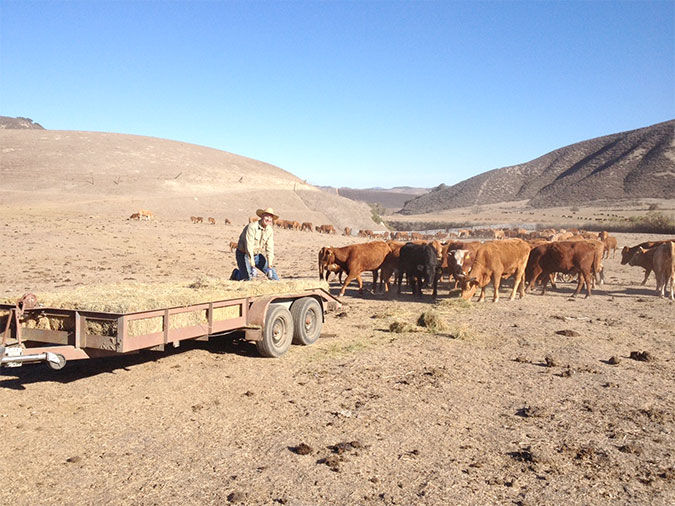Long before Gov. Jerry Brown's recent proclamation of the state's drought emergency, ranchers and farmers in the Archdiocese of Los Angeles were feeling the ill effects of many drier-then-normal seasons. The governor's official declaration of drought on Jan. 17 follows California's driest year on record contributing to dropping reservoir levels.
Kevin Merrill, of Mesa Vineyard Management overseeing 1,500 acres of wine grapes near Los Alamos between Santa Maria and Solvang, is very concerned about the unseasonably dry weather and how it will impact area vineyards.
As Merrill, a parishioner at St. Anthony in Los Alamos (a mission of St. Louis de Montfort in Santa Maria), told The Tidings, "We've had to irrigate the grapes for the second time already and usually we don't have to do that at all at this time of year --- it's the worst I've ever seen." He added that the vineyard is using a lot more natural gas to pump water out of the ground for irrigation.
Noting that the local temperature was 84 degrees on the day Brown proclaimed the state's drought emergency, Merrill, a board member of the Santa Barbara County Farm Bureau, said the sunny January weather makes for an unpredictable growing season. "We just don't know the effect of this warm weather and we're afraid the grapes are going to bud out early," something that's not supposed to happen until late February, commented Merrill.
"Right now," he pointed out, "the water table is pretty good and we're OK for another year, but we're concerned about water tables dropping and wells going dry if the drought continues through next year." According to Merrill, wells are going dry 90 miles north of Santa Maria in the Paso Robles area, and he is very concerned about vineyards they manage there.
Carson Scheller, an eighth generation California rancher who runs Rancho Los Alamos de Santa Elena, a cattle ranch with some of the land rented for vegetables or cultivation of flowers/vegetable seeds, told The Tidings that the drought is a disaster for cattle producers in California and has caused him to reduce his herd down to 100-head of cattle.
"The drought is affecting all of agriculture and mostly affecting animal producers who are dependent on rainfall for grazing cattle," said Scheller. "We're three years into a drought cycle, and this is the worst year yet. We've cut our herds back each year for three years because of the drought" on what is normally a 200-head ranch.
"This forces cattle producers to either sell out due to lack of grass or to supplementally feed hay, which is what we are doing here on the ranch. This is an additional expense you normally wouldn't have."
Scheller said he has been spending $300 a day every day for a month and a half. He noted that the price of hay is at an all-time high largely due to the high cost of transportation from the California/Arizona border.
"We're spending our savings and we have neighbors who've sold all their cattle," said Scheller. "Every week the auction yard has a sale of cattle like I've never seen before."
Scheller, related to Juan Jose Dominguez, the first Spanish land grant recipient in 1784 (Rancho San Pedro), notes that Santa Barbara used to be home of the vaqueros and now just a few cattle ranches remain in the area. If the drought continues through the November-May rainy season, he worries that cattle in California will be gone.
According to Scheller, the drought’s short-term impact is to ranches, but the long-term effect is overdraft to all water aquifers, which will affect farms and cities that draw their water from the ground. He pointed out that Lake Cachuma, which supplies the water for the City of Santa Barbara, is currently less than half full.
“You deal with what Mother Nature gives you,” said Scheller. “The last big drought in the early 1860s changed the history of California and it now looks to be repeated this year.”

